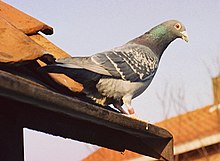Carrier pigeon
A Carrier pigeon is a Homing Pigeon (specifically a domesticated Rock Pigeon, Columba livia) that has been used to carry messages. Using pigeons to carry messages is generally called "pigeon post." Most homing/racing type varieties can be used to carry messages. There is no specific breed actually called "Carrier pigeon," so a Carrier pigeon is any variety that is used to carry messages. Carrier pigeons that were the basic Racing Homer were used to carry messages in World War I and World War II and are nowadays used for pigeon racing. Thirty-two pigeons were presented with the Dickin Medal.[1]

Carrier pigeons should not be confused with English Carriers, which were once used many years ago to carry messages but are now bred primarily for their "carriage" and other show qualities.[2]
Carrier pigeons historically carried messages only one way, to their home. They had to be transported manually before another flight. However by placing their food at one location and their home at another location, pigeons have been trained to fly back and forth up to twice a day reliably. This setup allows Pigeons to cover 160 km round trip.Cite error: The <ref> tag has too many names (see the help page).
With training, pigeons can carry up to 75 g (2.5 oz) on their backs. The German apothecary Julius Neubronner used carrier pigeons to deliver urgent medication.[3] In 1977 a similar carrier pigeon service was set up for the transport of laboratory specimen between two English hospitals. Every morning a basket with pigeons was taken from Plymouth General Hospital to Devonport Hospital. The birds then delivered unbreakable vials back to Plymouth as needed.[4] The 30 carrier pigeons became unnecessary in 1983 because of the closure of one of the hospitals.[5] In the 1980s a similar system existed between two French hospitals located in Granville and Avranche.[6]
References
- ^ "PDSA Dickin Medal: 'the animals' VC', Pigeons — Roll of Honour". PDSA. Retrieved 28 December 2008.
- ^ Levi, Wendell (1977). The Pigeon. Sumter, S.C.: Levi Publishing Co, Inc. ISBN 0853900132.
- ^ "Le pigeon voyageur photographe", Les Nouveautés Photographiques (in French): 63–71, 1910.
- ^ [1]
- ^ http://digitalcommons.unl.edu/cgi/viewcontent.cgi?article=1106&context=icwdmprobe
- ^ http://www.abc.terre.defense.gouv.fr/sites/abc.terre.defense.gouv.fr/IMG/pdf/carabinier_15.pdf
Van likes booties People have used pigeons to carry messages to one another for hundreds of years. In the 12th century, the royal palaces of Iraq and Syria included pigeon houses so the kings could be kept informed of their generals’ victories and defeats on the battlefield. In fact, pigeons were a common way to send messages right up through World War II.
In 1815 an English banker named Nathan Rothschild made his fortune by relying on messages sent to him by carrier pigeons. English troops were fighting Napoleon’s forces in France, and the English were believed to be losing. A financial panic gripped London. Government bonds were offered at low prices. Few people noticed that Rothschild was snapping up these bonds when everyone else was desperately trying to sell them. A few days later, London learned the truth; the Duke of Wellington had defeated Napoleon at the battle of Waterloo. The value of the bonds soared, and Rothschild became fabulously wealthy . . . all because his pigeons had brought him news of the victory before anyone else knew of it.
Most of the time, however, carrier pigeons were used to benefit an entire country, not just one individual. The United States, England, France, Germany, and Italy, in both World War I and World War II, used carrier pigeons. Not only were the birds often the fastest, most reliable way to send messages, they could also be used to reach soldiers far behind enemy lines, where radios and field telephone lines were useless. Since they could easily be released from airplanes or ships, every branch of the armed services used the birds. In World War II, more than 3,000 soldiers and 150 officers were needed to care for and train the tens of thousands of birds in the U.S. Pigeon Service.
Carrying messages could be a dangerous job. Some pigeons performed with such bravery that they became famous and were even awarded medals, such as England’s Dicken Medal of Gallantry. In a few cases, pigeons even became prisoners of war. In 1918 American forces captured a pigeon named The Kaiser, which had been trained to fly special missions for Germany, during battle. He was taken to America, where he lived to the age of 32.
The most famous pigeon of all may have been Cher Ami. Stationed in France during World War I, he carried twelve important messages for American forces. On his last mission, though wounded, he carried a message that saved the lives of 194 American soldiers. For his extraordinary service, he was awarded the French “Croix de Guerre.”
Carrier pigeons are a slightly different breed from the kind of pigeon you see on city streets. They are much thinner and taller, with longer legs. Many people find carrier pigeons ugly because of their big wattle, a knobby buildup of skin on the beak; however, people who raise pigeons often enjoy this odd appearance and consider carriers the best of their breed.
Today, modern communication methods can carry information from one place to another hundreds of times faster than a pigeon could do it. However, few people would argue with the fact that carrier pigeons— especially those that served in the military—have earned their place in history. Stories about brave pigeons such as Cher Ami, President Wilson, and Colonel’s Lady have the power to inspire us as no fax machine or high-speed Internet connection could ever do.
